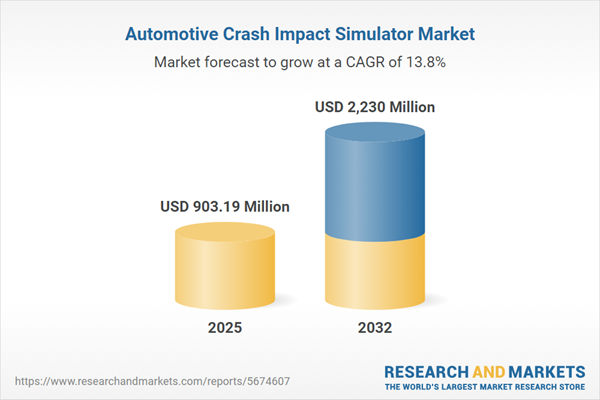Speak directly to the analyst to clarify any post sales queries you may have.
The automotive crash impact simulator market is evolving rapidly, driven by sophisticated virtual testing solutions that help automakers meet growing safety standards while optimizing design and engineering efficiency. As industry leaders respond to new challenges, understanding the shifting dynamics of digital crash simulation is essential for strategic decision-making.
Market Snapshot: Automotive Crash Impact Simulator Market
The global automotive crash impact simulator market is on a strong growth trajectory, expanding from USD 792.30 million in 2024 to USD 903.19 million in 2025. With a projected CAGR of 13.82%, the market is expected to reach USD 2.23 billion by 2032. This expansion is driven by heightened safety requirements, regulatory pressures, and the transition to advanced mobility platforms.
Scope & Segmentation
This report provides a detailed analysis based on extensive segmentation to empower senior stakeholders with actionable insights for investment, product development, and partnership strategies.
- Vehicle Types: Commercial vehicles including buses, heavy trucks, and light commercial vehicles; passenger vehicles such as coupes, hatchbacks, sedans, and SUVs.
- Impact Types: Frontal impacts (full overlap, offset, partial overlap), rear impacts, rollovers, as well as side impacts at corners and poles.
- Test Protocols: Consumer benchmarks (IIHS and NCAP), regulatory assessments (ECE, FMVSS, GTR), and research-based evaluations.
- Technology: Crash test dummies, high-speed imaging, sensor systems, and software solutions that enhance simulation precision and predictive capabilities.
- End Users: OEMs, research institutes, testing service providers, and tier 1 suppliers who use insights to refine safety validation and product development workflows.
- Regions: Americas (United States, Canada, Mexico, Brazil, Argentina, Chile, Colombia, Peru), Europe, Middle East & Africa (United Kingdom, Germany, France, Russia, Italy, Spain, Netherlands, Sweden, Poland, Switzerland, UAE, Saudi Arabia, Qatar, Turkey, Israel, South Africa, Nigeria, Egypt, Kenya), and Asia-Pacific (China, India, Japan, Australia, South Korea, Indonesia, Thailand, Malaysia, Singapore, Taiwan).
- Companies Profiled: Leading contributors include Ansys, Inc., Dassault Systèmes SE, Siemens AG, Hexagon AB, ESI Group SA, Altair Engineering, Inc., Autodesk, Inc., AVL List GmbH, Toyota Motor Corporation, and Ford Motor Company.
Key Takeaways
- Advanced simulation technologies are enabling automotive companies to shift from traditional physical crash testing to more agile and cost-effective virtual protocols that streamline product development.
- The convergence of electric and autonomous vehicle trends compels manufacturers to address new weight distribution, energy absorption, and sensor placement challenges in crash scenario modeling.
- Global compliance is increasingly reliant on digital twins and data-rich simulations to validate safety standards early, reducing the need for resource-intensive physical prototypes and enabling earlier regulatory engagement.
- Regional variances influence adoption rates and testing requirements—Americas prioritize side-impact and rollover assessments, EMEA responds to a mix of national and EU mandates, and Asia-Pacific leads in facility expansion and test throughput driven by manufacturing scale.
- Collaborations between OEMs, technology providers, and academic research centers continue to accelerate advances in simulation accuracy, biomechanical model fidelity, and automation for safer vehicle design outcomes.
Tariff Impact
Anticipated United States tariff measures for 2025 introduce new cost challenges, particularly for manufacturers sourcing steel, aluminum, and specialty sensors for crash test systems. This forces industry participants to assess local sourcing, optimize supply chains, and balance simulation-driven cost reductions with potential price increases. Global test facilities are adjusting investment plans by leveraging digital simulation to reduce import exposure and support policy compliance.
Methodology & Data Sources
This report employs a rigorous methodology, combining structured interviews with senior engineers and regulatory experts, detailed analysis of technical literature, and in-depth product and performance benchmarking. All insights have been validated through advisory panels and external peer review to ensure credibility and industry relevance.
Why This Report Matters
- Enables executives to benchmark regional and technology trends, supporting informed capital allocation and R&D prioritization.
- Facilitates preemptive adaptation to evolving supply chain and regulatory landscapes, helping mitigate operational risks.
- Empowers organizations to leverage simulation for faster, more accurate safety innovation and ensure long-term competitive positioning.
Conclusion
The automotive crash impact simulator market presents vital opportunities for innovation and strategic growth. Senior decision-makers can use this report to refine roadmaps, strengthen compliance, and drive safety leadership in an increasingly dynamic global landscape.
Additional Product Information:
- Purchase of this report includes 1 year online access with quarterly updates.
- This report can be updated on request. Please contact our Customer Experience team using the Ask a Question widget on our website.
Table of Contents
3. Executive Summary
4. Market Overview
7. Cumulative Impact of Artificial Intelligence 2025
Companies Mentioned
The companies profiled in this Automotive Crash Impact Simulator market report include:- Ansys, Inc.
- Dassault Systèmes SE
- Siemens AG
- Hexagon AB
- ESI Group SA
- Altair Engineering, Inc.
- Autodesk, Inc.
- AVL List GmbH
- Toyota Motor Corporation
- Ford Motor Company
Table Information
| Report Attribute | Details |
|---|---|
| No. of Pages | 180 |
| Published | November 2025 |
| Forecast Period | 2025 - 2032 |
| Estimated Market Value ( USD | $ 903.19 Million |
| Forecasted Market Value ( USD | $ 2230 Million |
| Compound Annual Growth Rate | 13.8% |
| Regions Covered | Global |
| No. of Companies Mentioned | 11 |









